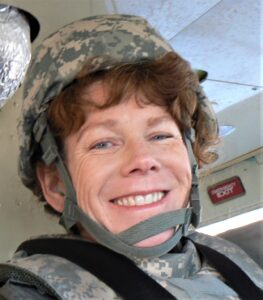
In the midst of the Iraq war in 2008, Carol Altstatt, an aikido black belt, built a dojo and taught aikido in the Green Zone – the heavily fortified center of Coalition Provisional Authority, located in the heart of Baghdad. This is her story of the experience, the challenge, and the growth and insight that blossomed from the experience.
Carol began aikido training in 1989 at Capital Aikikai under Clyde Takeguchi, Sensei. Several years later she joined the Aikido Schools of Ueshiba, headed by Mitsugi Saotome Sensei. While with A.S.U., she taught aikido at a private school for young women. She served two year-long deployments as a civilian in war: Iraq 2008-2009, and in Afghanistan, 2019.
The year was 2008. The position, Foreign Service social worker, was with the State Department and located in the U.S. Embassy, Baghdad (formerly the Iraqi Republican Palace), in the Green Zone. My role as a clinical social worker was to provide emotional and mental health support to those serving under the State Department, which meant Foreign Service officers, administrative staff and the diplomatic and personal security teams under the Chief of Mission, Ambassador Ryan Crocker. As the military had surged under General David H. Petraeus, so too had the civilians under the State Department. Altogether, my customer base was one thousand in Baghdad, and another eight thousand throughout Iraq. I kept a “go bag” packed because I could be ordered on a mission with short notice. The nascent role gave me latitude to give support in a range of forms and venues. I held individual therapy sessions in my embassy office, flew aboard helicopters to provide outreach to staff in provinces throughout the country, and volunteered to teach yoga and aikido for the Embassy’s community.
Given the risks and chaos in the Green Zone, it was a mixture of arrogance and idealism that let me think I could start a dojo there. I saw that a dojo could be a refuge in the center of the Iraq war’s intense, edgy headquarters. The conditions that created the need for a safe, contained space were the same ones to stifle my initiative: rotating personnel, incoming mortar rounds and rockets, security lockdowns, and sporadic improvised explosive device attacks. Erratic disruptions in Baghdad contrasted with stretches of idle hours, and I was compelled to teach. Once given the nod of approval, I imagined a lively, energetic dojo in the heartbeat of the war zone. As I did the legwork and relationship-building needed to find a practice space, recruit students, and gather equipment, I would find the most daunting obstacles not the kinetic activities outside the perimeter’s walls, but the personalities within.
Given the risks and chaos in the Green Zone, it was a mixture of arrogance and idealism that let me think I could start a dojo.
The year before the assignment, I’d flunked my nidan exam – potentially, an ego-busting outcome. Maybe that was the point. The testing happened the week after the Aikido Schools of Ueshiba (ASU) Annual Intensive one-week summer training program. The previous three cycles of testing had been held under panels of senior instructors, but this one was with Saotome Sensei. With only four examinees, we had the chance to shine or stumble and, though unlikely, failure was an option. It took less than an hour. Saotome Sensei took the center of the mat, gazed at us for several extended breaths and, with a long face, said, “Everybody fail.” The champagne a sempai had given me went into a dim corner of my refrigerator. Disconcerted by the smack-down, I vowed to show up with a beginner’s mindset the next day for early morning classes. Less than a year later I was in Iraq.
In preparation for deployment, the State Department held mandatory classroom and field instruction. We practiced triage for acute injuries, combat wound dressings, and pistol and M4 carbine familiarization. Security professionals taught us to drive cars at high speeds through horseshoe turns, and to weaponize a car to breach barricades. Terrorist role players threatened us from roadsides and enacted live bomb scenarios. While the survive, evade, resist, escape (SERE) module was a lightweight version of soldiers’ field training, it was enough to instill my vow to “return with honor” under any condition. Iraq was thick with thousands of contracted personal security details to protect us, but if an incident went sideways, we might have to tourniquet a limb, take the wheel, handle a firearm, and avoid being taken hostage.
The duck-and-cover alarm went off dozens of times, although never during class.
I knew firsthand the stakes we faced. For six years, I was a social worker at Walter Reed Army Medical Center, where we treated soldiers grievously injured in the contested areas of Afghanistan and Iraq. Amputations, traumatic brain injuries, and disfigurement brought me into proximity with a war in which the foe used guerilla tactics and skunkworks engineering to attack and bewilder fighting forces. Soldiers’ stories about a vehicle running low on gas, a mechanical jam in a dusty barrel of an M4, or a foot fall on one side or the other of a piece of plywood made the distinction between a near-miss and struggling for survival.
The interior of the palace, perhaps once softly lit by natural light, was dark, illuminated by flickering fluorescent tubes and bare bulbs strung from ceilings. Ceilings rose three stories above walls covered with murals showing horses galloping over mountains, and missiles breaking through clouds toward a blue sky. An expansive central hall was divided into smaller spaces – “carve-outs” – for various office functions. The temporary plywood carve-outs had no ceilings, leaving sound to ricochet from the walls and floors.
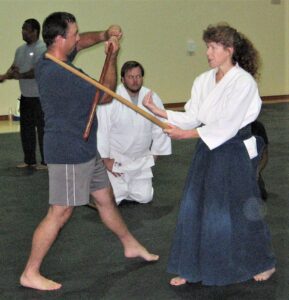
One of the dingy carve-outs, a heavily used recreation room, became our place of practice for the first six months. We had the space three evenings a week – Sunday through Tuesday – after a mixed martial arts class. The ceiling was high enough for weapons work. The marble floor was covered with spongy, duct-taped gymnastic mats. I took forward and backward rolls to judge the quality and it was unsuitable for rigorous ukemi. It lacked the density and forgiveness of decent mats. A supportive surface is the paramount condition for aikido training. We could get by with stretching and simple movement on the mats, but not rolling or falling ukemi. And without rolling and falling on trusted mats, aikido training is stunted.
It was each person’s responsibility to carry their own duffel bags when leaving Iraq, so I was reluctant to add to students’ baggage by requiring purchase of a bokken. During my walkabouts, I hit the equipment jackpot when I came upon an unpublicized carpentry shop set up in a shipping container. Officially, the carpenter, Jim, did projects approved by several layers of authorities; bokken and jo did not qualify as mission essential. I needed to find a way to make this happen. Using my own bokken and jo as templates, he made sixteen weapons for our budding dojo. Buoyed by this ground roots success, I hoped for the same result with the mats. Disagreement over the use of funds for community morale made me fight hard for the mats, so hard it nearly cost me my position.
The champagne a sempai had given me went into a dim corner of my refrigerator.Disconcerted by the smack-down, I vowed to show up with a beginner’s mindset the next day for early morning classes.
One detail perplexed and intrigued me: how to teach without an uke. In all of the classes, workshops, and camps I had attended, there was never a want for ukes. Spry, nimble, responsive, ukes are the raison d’etre of technique, the force without which there is no need for irimi or tenkan, the attack without which there is no technique.
The energetic intricacy between uke and nage is a kinesthetic phenomenon that has to be felt to be believed. A skilled nage struggles with his idea of technique when a beginner offers a floppy, disjointed attack. The beginner needs to feel the attack “from the center,” with intention and follow through, keep up momentum and remain connected. Without such an uke, partnership interaction was devoid of energy. I congratulated myself for what I considered an ingenious solution: I will be uke. I will be uke to students’ nage, allowing them to feel, through my responses, possibilities for moving through technique. Shaping space and movement like a windsock on an airfield. I would be the reflective other half, expanding into the negative space of their role as nage.
Uke quandary solved, only the quality of mats remained. Here, I met my primary adversary. Management held the purse strings, and my first request for decent mats was declined as “not mission essential.” It may have been an extravagant request – six thousand dollars’ worth of tatami-style mats – since they would be dedicated to a specific use for the duration of my tour. Step by step, I followed the bureaucratic rules to purchase equipment.

Ambassador Crocker was an advocate for the morale and welfare of staff, and even more so since the barrage during the spring attacks. He sanctioned my endeavor which was equivalent to a monetary green light. Month by month, we awaited delivery as we got by on the deteriorating gym mats. It took four months. Good mats meant we could have energized ukemi and the possibility of exuberant training. As an instructor, I was firm about etiquette and kept chatter to a minimum during class. As uke, my learning evolved with the recognition I am always less than one student away from a beginner.
Notice of the start of classes went to the Embassy’s distribution list and was posted on bulletin boards in high traffic spots. The physician in the medical unit where I worked cautioned, “Don’t be surprised if no one shows up.” I offered classes because people needed diversion from long work days in a frustrating environment. If no one showed, I’d train by myself. Thirteen people showed up for the first class. Attendance increased every month and by the end of the year over forty people sampled classes. I took ukemi and within weeks several of the regulars were able to demonstrate with me. I was so immersed in their development, and in myself serving as uke, that at times I imagined myself the teacher only one lesson ahead of his pupils.
We could get by with stretching and simple movement on the mats, but not rolling or falling ukemi. And without rolling and falling on trusted mats, aikido training is stunted.
Those who joined us reflected the diversity of our community. Some were previously on active duty in the military and working as security contractors. One, David, with a boisterous personality and a grin to match, had been wounded as a combat soldier in Iraq and had returned as a contractor in information technology. A Navy pilot, Luke, was a family man, athletic, and solid as a rock. Others were economic or political diplomats, one was with USAID, and there was a sprinkling of foreign nationals who were on cooking or cleaning crews. Several women joined as well, including a nurse I worked with in the medical unit.
As a dojo, we had vigorous training, and classes ended with the kind of satisfaction that made students want to return for more. We held ninety hours of classes. David and Luke were ecstatic to pass sixth kyu and strutted in their hakamas like roosters. We used the tatami-style mats for four months and students were free of injuries. The duck-and-cover alarm went off dozens of times, although never during class.
It may have been providence that spared me what I considered the ultimate test of the durability of my budo spirit that year. I yearned to test my wits in a life-threatening situation which was practically guaranteed in pre-deployment training. Our community was under lockdown several times, but mortar shells never landed on our grounds. However, I did offer care and comfort to those who met the enemy, such as the security personnel who lost a teammate with a gunshot wound to the head, those who knew two people killed by bombs in off-site meetings, and the witnesses of a vehicle-borne improvised explosive device that killed two Foreign Service officers. The startling revelation had to do with my misperception of an opponent. Those inside our walls, our fellow citizens, had the capacity to make or break our experience while serving in a desolate, hostile land. The contest over the mats exposed stubbornness as one of my own weaknesses, but my triumph gave us the ground for a level of aikido never previously seen in the Green Zone and, I doubt, since.
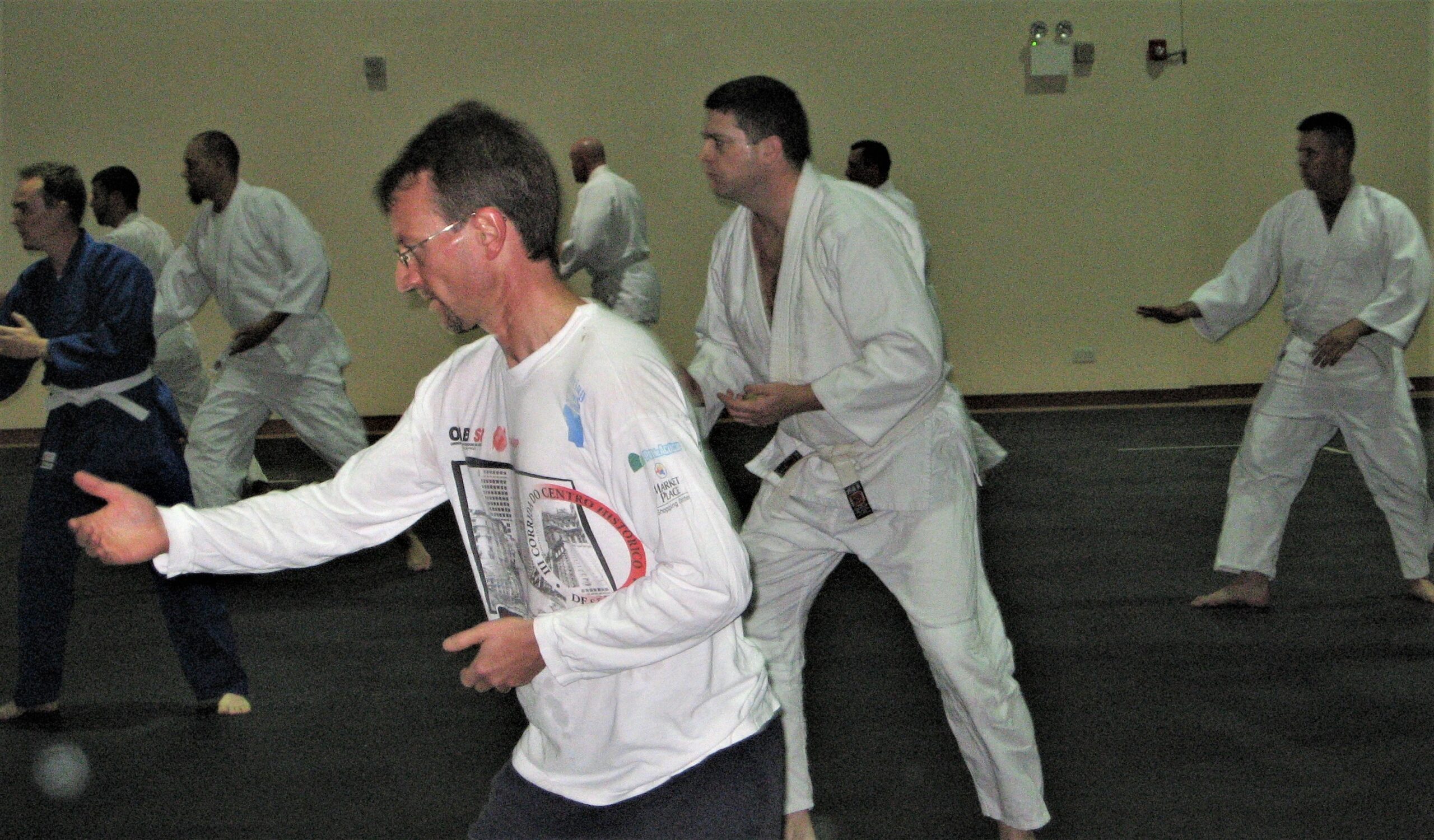
It was heartening to see students blossom through time on the mat, to catch the twinkle of inspiration in their eyes. The core group that evolved was primed to continue training wherever their next venture took them. These were people who hungered for the spirit of aikido, even if they could not have expressed it. All I did was show up. The presence of such eager trainees made me the prime beneficiary of the eleven-month dojo experiment.
Back home, I opened my sempai’s bottle of champagne. I’d surpassed the wartime version of my nidan exam.

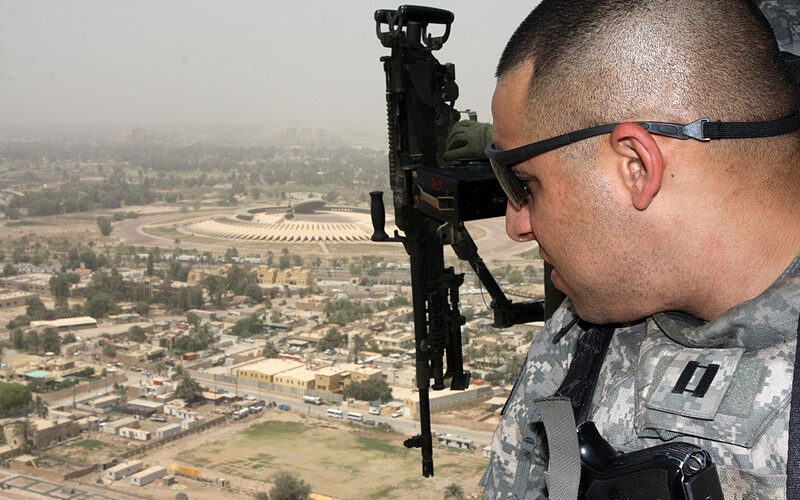


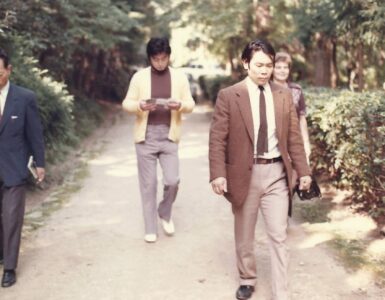
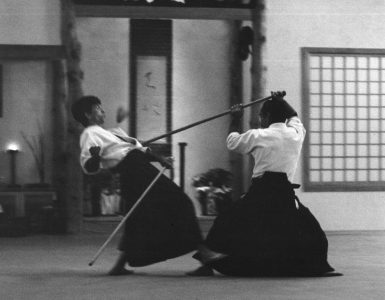







Great story!!!
After reading this article I have to say after at least 5 years I went to get back in the dojo great article great inspiration
Fabulous! Thank you.
Robert Kravetz
Aikido in Fredericksburg
Alright Carol! Great article and great to see your pics – I still remember you teaching at Cathedral School in DC.
Cheers,
Mark
Hello, to you, Mark! Good to hear from you.
The Green Zone was the center of the coalition authority in Iraq. Aikido is only effective if one centers oneself. This a story about centering in the center. Very good story; very inspiring!
What a wonderful service!
Thanks for sharing this Carol! A fine recounting of your experience and learning, And thank you for your service.
Carol you created a wonderful refuge
within the insanity of the Iraq war.
Thank you for your service.
Thank you for thanking me, Doug!
Hello,
Carol was probably one of the single most important students at Aikido Shobukan Dojo when I arrived on series of MAC flights from Alaska to visit the dojo, as I was still in the US Army at the time.
Carol was working in the dojo gardens and looked up and asked about me, where I was from, and then said there was a special yudansha seminar going on and that she’d seek permission for me to observe. She returned and said that it was ok to come in. That was the day my life turned 90 degrees hard flank left into uchi-deshi life with Saotome Sensei and I thank Carol for that. It was her presence and grace that impressed me during the transition into the dojo, and her hand gestures had served as prompts without the explicit—a hallmark of culture, work, and training.
I am in gratitude that this story is here to see Carol’s contributions to our forces of military and state come to light.
Thank you,
RÆH
Wow, Carol, this is a wonderful story from an even more wonderful in so
Many ways, individual, A role model for sure. Hope you continue to excel.